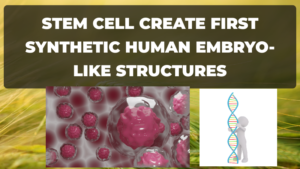Stem Cell create first synthetic human embryo-like structures
Recently, a team of scientists in the US and the UK have created the first synthetic human embryo-like structures in the world using stem cells bypassing the need for eggs and sperm.

More on news
• These synthetic embryos resemble natural embryos in the earliest stages of human development.
• They lack a beating heart or the beginnings of a brain, but they contain cells that would give rise to the placenta, yolk sac and the embryo.
• These models would help scientists understand the impact of genetic disorders and the biological reasons behind recurrent miscarriages.
o Research will help scientists understand the “black box of human development”, the period before a pregnancy’s progress can be detected on a scan
Image credit: Internet
Relevance of stem cells in biomedical research and therapies
• Understanding nature of disease: Information on genetic and molecular signals that regulate differentiation in stem cells can help understating development of diseases and finding therapy.
• Stem cell therapy (SCT): Also known as regenerative medicine, the SCT refers to introducing new stem cells into damaged tissue to treat a particular type of disease.
o It could be either Autologous transplantation (uses the patient’s own stem cells) or Allogeneic transplantation (uses stem cells from a donor).
• Toxicology (drug side effects): Testing drug candidates directly on patients can be extremely dangerous.
o However, iPS cells can be differentiated into the requisite cell type, and the drugs tested on them for reactions.
Current status of use of Stem cell therapy (SCT) in medicine
• The only stem cells now used to treat disease are hematopoietic stem cells found in bone marrow.
• These cells are used in bone marrow transplants to help people with cancer make new blood cells.
• They may also be used to treat people with conditions, such as Fanconi anemia, a blood disorder that causes the body’s bone marrow to fail.
Challenges related to stem cell technology
• Ethical issues in stem cell : Ethical dilemma involving the destruction of a human embryo and differentiation potential of iPSCs which can be used in human reproductive cloning.
• Safety concerns: Due to higher deferential rates, stem cells have a much higher probability of accumulating genetic mutations and leading to tumor growth or cancer.
• Immune rejection: There are issues with post-transplant rejection of embryonic stem cells (since they cannot be used from a patient’s own cells).
• Understanding stem cell mechanism: It is not yet clear whether the synthetic embryos have the potential to continue maturing beyond the earliest stages of development. For example,
o In Israel and China efforts to develop synthetic embryos, grown from mouse and monkey, by implementing it in the womb of the respective animals failed.
o So, it is not clear whether the barrier to more advanced development is merely technical or has a more fundamental biological cause.
• Legal issues: The use of synthetic embryos for clinical purposes is not legally imminent in the UK and most other
countries. Implanting them into a patient’s womb is currently illegal.
• Other issues: Stem cell therapies costs are highly expensive, and it is difficult for developing nations to keep pace with technological advancements.
Way ahead for stem cell research
• Resolving ethical dilemma of stem cell:
o Ensure regulatory framework and mechanisms can keep up with the rapid pace of changes in stem cell research
and ground realities.
o Continuous endeavor to actively engage with all stakeholders and come up with timely and suitable reforms.
o Resolving regulatory issues to prevent unscientific or unethical stem cell therapy that poses a threat to the wellbeing of patients and other vulnerable individuals.
• Tackling safety concerns: Under controlled conditions, stem cells derived cells could serve as a potentially safe new source in regenerative medicine.
• Promoting R&D: Scientists must first learn more about how embryonic stem cells develop. This will help them
understand how to control the type of cells created from them and facilitate Informed decision making.
o Quality clinical research also demands skilled human resources besides adequate finance.
• Collaboration: Private sector funding, international collaborations, and the promotion of exchange studies.
• Awareness against the misuse: Regulatory bodies need to ensure that people are aware about the availability of stem cell therapy and the therapies which are banned.
Read about:

